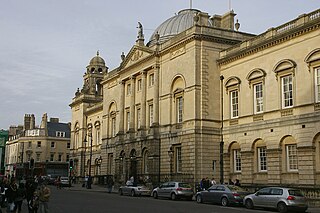
Newport is a market town in the borough of Telford and Wrekin in Shropshire, England. It lies 7 miles (11 km) north-east of Telford town centre, 12 miles (19 km) west of Stafford, and is near the Shropshire-Staffordshire border. The 2001 census recorded 10,814 people living in the town's parish, which rose to 11,387 by the 2011 census.

Portsmouth Guildhall is a multi-use building in the centre of Portsmouth, Hampshire, England. It is located in a pedestrian square close to Portsmouth and Southsea railway station. Constructed in 1890, the building was known as Portsmouth Town Hall until 1926. It was heavily damaged by bombing during the Second World War and largely rebuilt during the 1950s by the English architect Ernest Berry Webber. It now operates as a concert, wedding and conference venue. It is a Grade II listed building.

Aqualate Hall, a 20th-century country house, is located in Forton, Staffordshire, England, some 2 miles (3.2 km) east of the market town of Newport, Shropshire and 10 miles (16 km) west of the county town of Stafford. It is a Grade II* listed building.

St Nicholas's Church is an Anglican church in the market town of Newport, Shropshire, England lying within the Diocese of Lichfield. It is dedicated to St Nicholas, the patron saint of fishermen. The church is a Grade II* listed building.

Guildhall is an 18th-century municipal building in central Bath, Somerset, England. It is a Grade I listed building.

Exeter Guildhall on the High Street of Exeter, Devon, England has been the centre of civic government for the city for at least 600 years. Much of the fabric of the building is medieval, though the elaborate frontage was added in the 1590s and the interior was extensively restored in the 19th century. It is a Grade I listed building.

The Guildhall is a historic building in Bore Street in Lichfield, Staffordshire in the United Kingdom. The guildhall is a Grade II listed building.

The Much Wenlock Guildhall is a guildhall located on Wilmore Street in Much Wenlock, Shropshire. It is a Grade II* listed building.

Weymouth Guildhall is a former guildhall at Weymouth, Dorset, England. The building, which was constructed in the 1830s, is a Grade II* listed building.

The Guildhall in Barnstaple in Devon in the United Kingdom is the Guildhall for the town and was completed in 1828, replacing an earlier Guildhall. Beneath and behind the Guildhall is the Pannier Market; completed in 1855, the building has been a Grade II* listed building since 19 January 1951.

The Worcester Guildhall is a municipal building in the High Street, Worcester, England. It is a Grade I listed building.

Bury St Edmunds Guildhall is a municipal building in the Guildhall Street, Bury St Edmunds, Suffolk. It is a Grade I listed building.

Stratford-upon-Avon Guildhall is a historic building in Church Street, Stratford-upon-Avon, Warwickshire, England. It is a Grade I listed building. Dating from the early 15th century, the Guildhall was for centuries at the centre of life in Stratford, being used for assemblies, as a meeting place for the local council, and as a school building for the King Edward VI School. Most famously William Shakespeare almost certainly attended school here. The building was opened to the public in 2016, after being restored.

Thaxted Guildhall is a municipal building in Thaxted, Essex, England. It is a Grade I listed building.

The Old Shirehall was a municipal facility in Market Square, Shrewsbury, Shropshire. It was demolished in 1971 to make way for a retail and commercial centre.

Faversham Guildhall is a municipal building in the Market Place in Faversham, Kent, England. The structure, which was the meeting place of Faversham Borough Council, is a Grade II* listed building.

St Ives Guildhall is a municipal structure in Street An Pol, St Ives, Cornwall, England. The structure, which is the meeting place of St Ives Town Council, is a locally listed heritage asset.

The Old Town Hall is a municipal building in St Mary Street, Newport, Shropshire, England. The structure, which is now divided into a series of shop units on the ground floor and used as a children's play area on the first floor, is a Grade II listed building.

Bradninch Guildhall is a municipal building in Fore Street, Bradninch, Devon, England. The structure, which is now used as a community events venue, is a Grade II listed building.

Ludlow Guildhall is a historic building in Mill Street in Ludlow, a town in Shropshire, in England. The building, which accommodates the offices and meeting place of Ludlow Town Council, is a Grade I listed building.





















